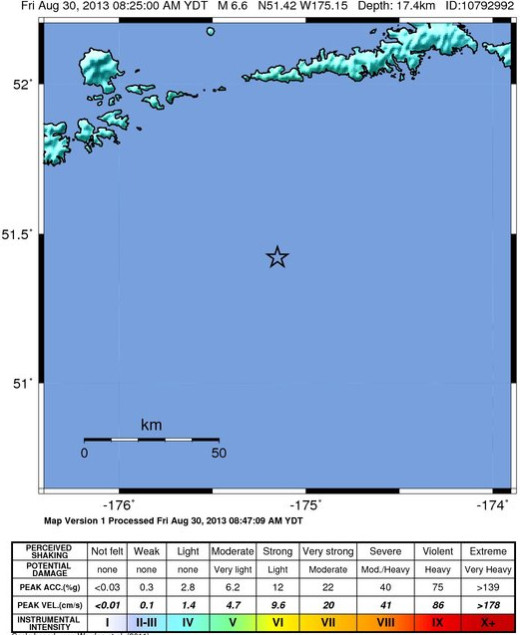HILO, Hawaii: A strong earthquake off Alaska’s Aleutian Islands did not create a tsunami threatening Hawaii, emergency officials say.
The Pacific Tsunami Warning Center reported befre 7 a.m. Hawaii Time that an earthquake of magnitude 7.0 occurred in the Alaskan waters. The magnitude was later changed to a 6.6 earthquake.
Any strong earthquake in the area of the “Aleutian arc” bears watching. Hilo has been directly impacted by seismic activity here in the past.
This historical information is from the USGS Event Page for the most recent Aleutian quake:
| The Aleutian arc is a seismically active region, evidenced by the many moderate to large earthquakes occurring each year. Since 1900, this region has hosted twelve large earthquakes (M>7.5) including the May 7, 1986 M8.0 Andreanof Islands, the June 10, 1996 M7.9 Andreanof Islands, and the November 17, 2003 M7.8 Rat Islands earthquakes. Six of these great earthquakes (M8.3 or larger) have occurred along the Aleutian arc that together have ruptured almost the entire shallow megathrust contact. The first of these major earthquakes occurred on August 17, 1906 near the island of Amchitka (M8.3) in the western Aleutian arc. However, unlike the other megathrust earthquakes along the arc, this event is thought to have been an intraplate event occurring in the shallow slab beneath the subduction zone interface.
The first megathrust event along the arc during the 20th century was the November 10, 1938 M8.6 Shumagin Island earthquake. This event ruptured an approximately 300 km long stretch of the arc from the southern end of Kodiak Island to the northern end of the Shumagin Islands and generated a small tsunami that was recorded as far south as Hawaii. The April 1, 1946 M8.6 Unimak Island earthquake, located in the central Aleutian arc, was characterized by slow rupture followed by a devastating Pacific-wide tsunami that was observed as far south as the shores of Antarctica. Although damage from earthquake shaking was not severe locally, tsunami run-up heights were recorded as high as 42 m on Unimak Island and tsunami waves in Hilo, Hawaii also resulted in casualties. The slow rupture of this event has made it difficult to constrain the focal mechanism and depth of the earthquake, though it is thought to have been an interplate thrust earthquake. The next megathrust earthquake occurred along the central portion of the Aleutian arc near the Andreanof Islands on March 9, 1957, with a magnitude of M8.6. The rupture length of this event was approximately 1200 km, making it the longest observed aftershock zone of all the historic Aleutian arc events. Although only limited seismic data from this event are still available, significant damage and tsunamis were observed on the islands of Adak and Unimak with tsunami heights of approximately 13 m. The easternmost megathrust earthquake was the March 28, 1964 M9.2 Prince William Sound earthquake, currently the second largest recorded earthquake in the world. The event had a rupture length of roughly 700 km extending from Prince William Sound in the northeast to the southern end of Kodiak Island in the southwest. Extensive damage was recorded in Kenai, Moose Pass, and Kodiak but significant shaking was felt over a large region of Alaska, parts of western Yukon Territory, and British Columbia, Canada. Property damage was the largest in Anchorage, as a result of both the main shock shaking and the ensuing landslides. This megathrust earthquake also triggered a devastating tsunami that caused damage along the Gulf of Alaska, the West Coast of the United States, and in Hawaii. The westernmost Aleutians megathrust earthquake followed a year later on February 4, 1965. This M8.7 Rat Islands earthquake was characterized by roughly 600 km of rupture. Although this event is quite large, damage was low owing to the region’s remote and sparsely inhabited location. A relatively small tsunami was recorded throughout the Pacific Ocean with run-up heights up to 10.7 m on Shemya Island and flooding on Amchitka Island. Although the Aleutian arc is highly active, seismicity is rather discontinuous, with two regions that have not experienced a large (M>8.0) earthquake in the past century: the Commander Islands in the western Aleutians and the Shumagin Islands in the east. Due to the dominantly transform motion along the western arc, there is potential that the Commander Islands will rupture in a moderate to large strike-slip earthquake in the future. The Shumagin Islands region may also have high potential for hosting a large rupture in the future, though it has been suggested that little strain is being accumulated along this section of the subduction zone, and thus associated hazards may be reduced. East of the Aleutian arc along the Gulf of Alaska, crustal earthquakes occur as a result transmitted deformation and stress associated with the northwestward convergence of the Pacific plate that collides a block of oceanic and continental material into the North America plate. In 2002, the Denali Fault ruptured in a sequence of earthquakes that commenced with the October 23 M6.7 Nenana Mountain right-lateral strike-slip earthquake and culminated with the November 3, M7.9 Denali earthquake which started as a thrust earthquake along a then unrecognized fault and continued with a larger right-lateral strike-slip event along the Denali and Totschunda Faults. |


by Big Island Video News8:18 am
on at
STORY SUMMARY
HILO, Hawaii: A strong earthquake off Alaska’s Aleutian Islands did not create a tsunami threatening Hawaii, emergency officials say. The Pacific Tsunami Warning Center reported befre 7 a.m. Hawaii Time that an earthquake of magnitude 7.0 occurred in the Alaskan waters. The magnitude was later changed to a 6.6 earthquake. Any strong earthquake in the […]